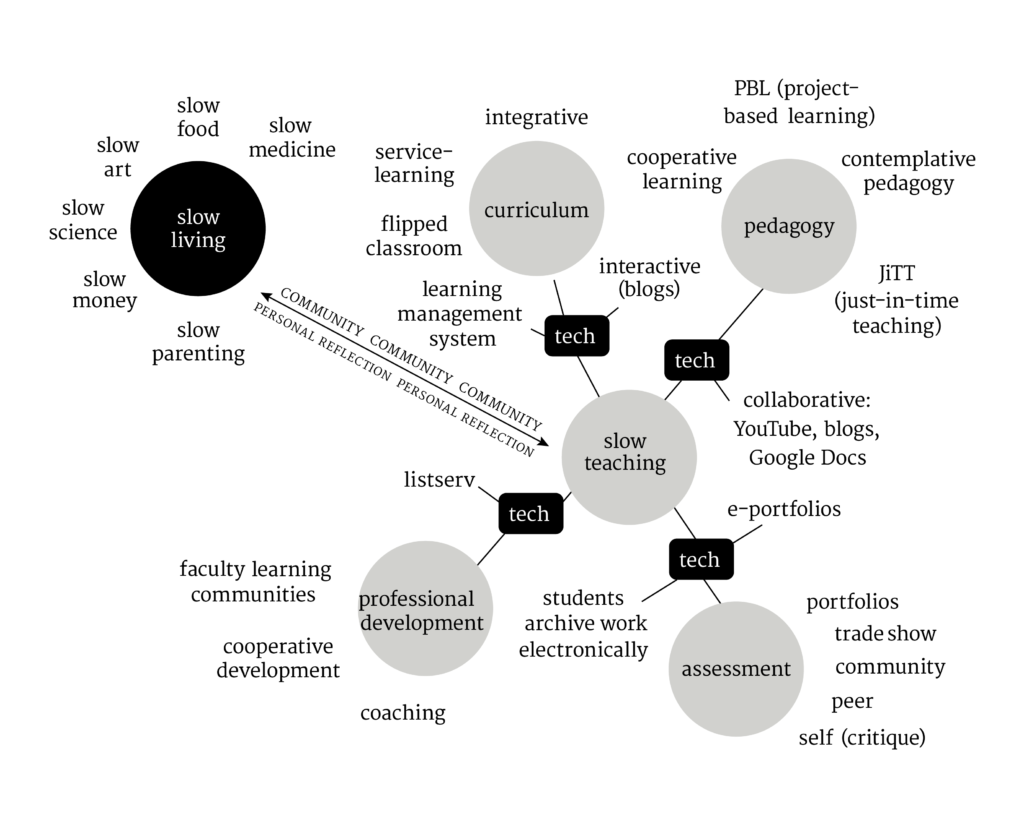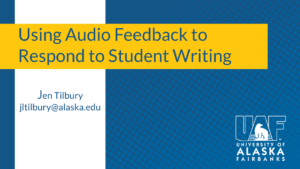
Slow Pedagogy
You have probably heard about slow something: slow food, slow fashion, slow living. What about slow pedagogy?
Growing from the general “slow” movement, first sparked in the 1980s with the Slow Food Movement (in opposition to the dominance of the fast food industry), the conversation surrounding slow education started gaining traction in early 2000s (Clark, 2021). The movement is a critical response to what “slow” scholars consider an “impatient” approach to schooling, which emphasizes reaching learning objectives as quickly and efficiently as possible (Biesta, 2012). Resistance to “pressurized” schooling is another important element: slow teachers may seek to reduce the emphasis on academic performance and hitting pre-set goals at pre-set times (Clark, 2021). Further, slow pedagogy speaks to the working conditions of academia. As Guest (2020) notes, “even where institutions appear to give time and space to academics, speedy temporalities can dominate.” Slow pedagogy contends that while busyness is the bread and butter of academia, a hurried education can negatively impact deep learning–and perhaps even more importantly, diminish the joys of the learning process.
Takeaways
- Slow pedagogy is an approach to teaching that emphasizes the importance of deep learning and the joys of the learning process.
- A slow approach can help instructors make holistic course revisions.
- Slow pedagogy encourages instructors to adopt natural pacing, emphasize process over content, and go slow with technology.

Slow pedagogy is a growing trend at many sites of education, ranging from higher education to early childhood. Starting in a preschool, slow pedagogy can look like taking the time to let children serve themselves at a mealtime or spending extra time on nature walks, like stopping to observe how autumn leaves fall from a tree. In later education, slow pedagogy can be a way to de-emphasize formal assessment, as well as resisting a crammed schedule. The important thing is that slowness, in this sense, is not “a slow-motion version of postmodern life” (Parkins & Craig, 2006, as cited in Shaw & Russell, 2013, p. 320), but an altogether alternative approach. In other words, slow pedagogy is not just taking your regular course calendar and adding more space between due dates; it invites instructors to reflect on how a class is designed and facilitated. From this space, teachers can cultivate awareness of how and why certain content is taught–and to extend that culture of attentiveness to your students.
It is important to acknowledge that not everybody can (literally and figuratively) afford to allocate more time to their teaching practice. Guest (2020) clarifies that access to slowness is not universal, and that time pressures are felt differently between rank, position, and identities. And it can be difficult even for those for whom slowing down is possible. For example, Guest develops her theory of slow pedagogy through slowly reading a relevant novel (not a norm in her discipline). She had the option to do so “on the clock,” so to speak, yet noticed herself mentally preparing to defend her reading material. There is a discomfort in moving slowly in a culture where busyness is often equated with success.
While slowness remains “counter-cultural,” so to speak, individuals won’t necessarily be able to completely change the pace of academic work. However, there may be opportunities to make small nudges. For us in a higher education context, it’s also interesting to note that Clark’s research suggests that “pressurized” education “filters back” – that the pressure of more advanced education eventually wends its way back to even the earliest education. What could the ripple effects be if we in the most advanced educational context focused on slowing down?
All that said, it is not necessarily possible to carve a linear path to “slow.” And as slow pedagogy “values the difficult to measure” and “values process over outcome” (Clark, 2021), it is not a pedagogical practice that one can simply achieve or arrive at. With that in mind, the rest of the Teaching Tip offering a few insights and ruminations from slow pedagogy research that could inform your own slow pedagogy journey:
“Reconsider the relationship with time”
Sylvia Kind, a Canadian early-childhood educator interviewed by Clark, defined the most important part of slow pedagogy as “being with” – being with people and ideas at their natural pace. While “slowness” is, of course, emphasized, slow pedagogy does not require instructors to move through everything at a plodding pace. A “slow pedagogy” can move fast when the class is inspired or when it suits the content. Yet it is unhurried when the class and content wants to move slowly or reflectively. As you plan your course, how could you “reconsider the relationship with time” (Clark, 2021), creating space for your pace to ebb and flow?
Emphasize process, deemphasize content
With so much content to cover in such a short time period, it can be extremely difficult to winnow down your course to-do list. If density is propelling hurriedness in your course, Shaw and Russell (2013) offer a practical example through a look at history education. When preparing a course in most disciplines, it can be tempting to try to cover everything. Of course, this impulse is not possible in any discipline, but it is patently impossible in teaching history. As a result, Shaw and Russell (2013) argue that contemporary history instruction instead focuses “uncoverage,” focusing on only the most useful education content (historians, feel free to chime in if this sounds familiar with a comment!).
But how do you determine what content is the most useful? You consider what material will allow students to practice disciplinary approaches. Shaw and Russell (2013) put it, “Which topics will best facilitate the exposure of students to core values and discipline-specific behavioral and cognitive patterns” (p. 324)? If students are taught to think like historians, they are better equipped to decode their own evidence. This frees up the reading list, as instructors focus on providing the course materials that provide the best practice for learning the disciplinary process.
Go slow with technology
Teachers seeking slowless can find it useful to go slow with technology in both senses of the phrase. Education technologies can be great tools to facilitate slow practices, like student collaboration and discussion that spans beyond the classroom. It also can be extremely helpful to apply the mindful approach of slow pedagogy to selecting digital technologies for the classroom.
Shaw and Russell (2013) emphasize that slow pedagogy is somewhat agnostic about technology in the classroom. Slow teaching can happen in a screen-free class meeting; it can also drive deep engagement with a certain technology throughout the course. In either case, Shaw and Russell (2013) “recommend that technology integration decisions be carefully weighed, considering work-life balance, speed, intentionality, and informational and mental capacity” (p. 322). In our current technological climate, I would also suggest evaluating how much a particular tool contributes to (or manufactures) urgency when deciding if you’d like to invite it in your class. No matter the ultimate decision, the key is to remember that “efficient knowledge acquisition for the sake of speed is no match for deep engagement, regardless of the tools used.” (Shaw & Russell, 2013, p. 322)
References
Alison Clark. (2021, December 2). The Urgency of Slow. The Urgency of Slow – Session 1. https://www.youtube.com/watch?v=GVw558ilMkU
Biesta, G. (2012). The Educational Significance of the Experience of Resistance: Schooling and the Dialogue between Child and World. Other Education: The Journal of Educational Alternatives, 1(1), 92-103.
Guest, C. (2020, January 27). Teaching on the Edge of Time: Developing a Slow Pedagogy through Feminist Science Fiction. MAI: Feminism & Visual Culture. https://maifeminism.com/teaching-on-the-edge-of-time-developing-a-slow-pedagogy-through-feminist-science-fiction/
Shaw, P. A., & Russell, J. L. (2013). 19 Determining Our Own Tempos. To Improve the Academy: A Journal of Educational Development, 32. http://dx.doi.org/10.3998/tia.17063888.0032.023




